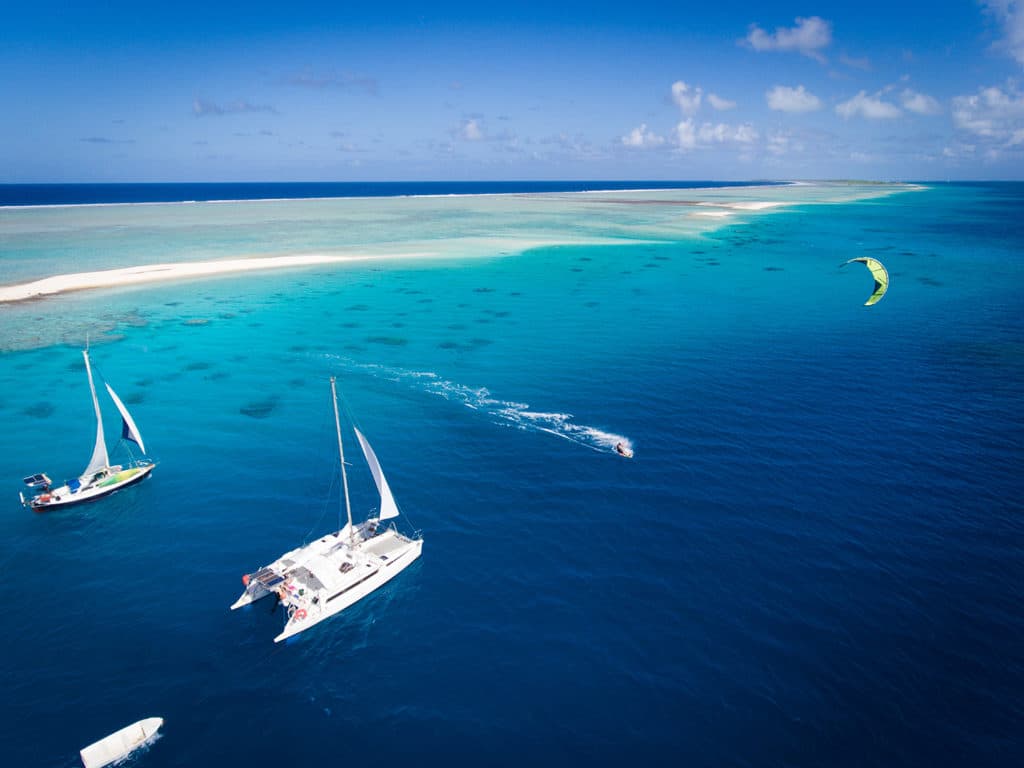
Finding a way to finance your lifestyle while cruising in remote places is one of the many challenges faced by sailors. Adrian Cartier Millon, a French kitesurf instructor, had a unique idea in mind when he set off from France six years ago aboard his Laurin Koster 28, Eureka. He was headed for New Caledonia in the South Pacific, where he’d heard the conditions were perfect to start a kite school, which he wanted to run from his boat.
Originally from Marseille, Millon set sail from the south of France and headed west across the Atlantic to the Caribbean, transited the Panama Canal, and entered Pacific waters for the first time, teaching kiteboarding as he went. He never made it to New Caledonia however. Instead he stumbled across a lesser-known kitesurfing paradise on his way across the Pacific in the lagoons of the Tuamotu atolls. The location for his kite school soon changed, and he’s been kitesurfing and sailing around those great rings of coral reef ever since. Not yet an official kite spot, it was Millon’s experience and understanding of the conditions that allowed him to take advantage of being the first to set up shop there.
The Tuamotu archipelago consists of around 80 islands and atolls, blessed with almost-consistent 15-knot wind during the windy season from April to October. Inside the lagoon, sheltered by a rim of coral, the water stays comparatively flat, and there are no mountains in sight to interrupt the steady blow of southeasterly trades. Fakarava is the second largest atoll of the archipelago, with a lagoon that stretches 30-miles from north to south and 10 miles from east to west. In the southeast corner of this lagoon exists a small motu (a Polynesian word for “small island” or “coral islets”), which at high tide is just a few hundred square meters and changes shape with each tide as the swell pushes the sand around. Millon likes to joke that his “office” is on this sandbank, and he anchors Eureka downwind from here to take advantage of the ideal conditions for kitesurfing that the location provides. Free from the usual sprinkling of coconut trees so often found along the perimeter of these atolls, kitesurfers here can make the most of constant, uninterrupted wind.
Millon brought all the materials with him that he needed to set up the school with him when he set sail from France, renewing it over the years, upgrading the kites as the technology advances. He anchors a dinghy full of kites, boards, harnesses, wetsuits and helmets on this motu, which, due to his friendly, fun-loving nature, is starting to become popular for other kitesurfers on sailboats who come to hang out, enjoy the wind, and train on new equipment like foil boards. The surrounding turquoise waters are now often dotted with colorful kites zipping back and forth.
The remoteness of the school’s location has other benefits as well. With most atolls in the Tuamotus having fewer than 1,000 residents, and usually fewer than a dozen boats at a time in each anchorage, you won’t have to compete with other kiteboarders for space, and beginners don’t have to worry about getting lines tangled with others. Best of all, it also means you usually get an instructor all to yourself.
The beauty of running the school from his sailboat is that Millon’s classes aren’t limited to this area alone. He can move around the lagoon (or even the archipelago), changing spots to suit the wind conditions or the clients. Millon doesn’t even need a sandbank for his kite school because he can store the kit on his sailboat and launch a kite from the dinghy.
It is totally apparent from his instinctive reactions, behavior and manipulation of the wind, whether on a boat or a board, that Millon grew up with the breeze in his sun-bleached hair and waves under his feet. He’s kiteboarded for more than 20 years and been an instructor for over 10 after completing a strict yearlong kite-sport instructor program in Brittany, one of the roughest, windiest areas of France, which allows him to teach any watersport pulled by kite.
A large number of his clients are sailors, passing through on their way across the Pacific. The rest are mostly friends or residents from Tahiti visiting for their holidays. For the past year, Millon has teamed up with Aline Dargie from California, a fellow kitesurfer (also once one of his students) and captain of an Edel Catamaran 35 Open called Pizza. Together they already have kitesurfing friends visiting from all over the world and are expanding their business to attract new clients.
If you find yourself in one of the Tuamotu atolls and are interested in giving kiteboarding a try, check out Tuamotu Kite School.








